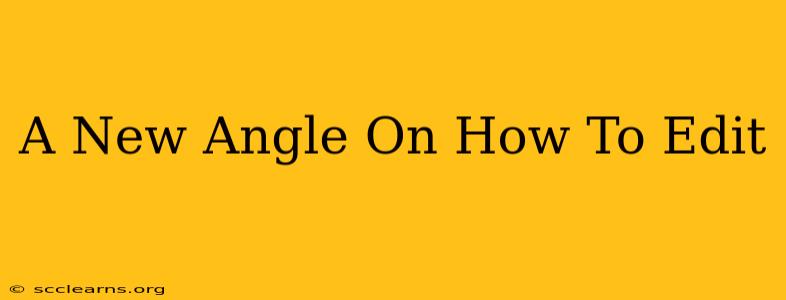So, you want to learn how to edit? Forget the tired old advice about just focusing on grammar and spelling. While those are crucial, true editing goes far beyond the surface level. This post unveils a fresh perspective on the editing process, revealing the secrets to transforming good writing into great writing. We’ll explore techniques that elevate your content, boost your SEO, and captivate your readers.
Beyond the Basics: The Three Pillars of Powerful Editing
Effective editing isn't a single task; it's a three-pronged approach:
1. The Structural Edit: Building a Strong Foundation
This stage focuses on the overall architecture of your piece. Think big picture:
- Content Flow: Does the information flow logically? Are there any jarring transitions? Rearrange paragraphs or sections if necessary to create a smooth, coherent narrative. This is crucial for user experience and SEO, keeping readers engaged and search engines happy.
- Clarity and Conciseness: Is every word necessary? Eliminate jargon, fluff, and redundant phrases. Strive for clarity and impact. Each sentence should serve a purpose, driving your message forward.
- Argument & Thesis (if applicable): If writing an essay or opinion piece, is the central argument clear and consistently supported throughout? Does the conclusion effectively summarize the main points?
2. The Mechanical Edit: Polishing the Prose
This is where traditional grammar and spelling checks come into play. However, it's more than just a spell-check run:
- Grammar & Punctuation: Thoroughly review grammar and punctuation. Utilize grammar checkers, but don't rely on them completely; always proofread manually.
- Style Consistency: Maintain a consistent style throughout your piece. Pay close attention to things like capitalization, formatting, and number usage.
- Word Choice: Are you using the strongest, most precise words possible? Consider synonyms and evocative language to enhance your writing's impact.
3. The Substantive Edit: Adding Depth and Impact
This is where you truly elevate your content:
- Voice and Tone: Does the writing reflect the intended audience and purpose? Is the tone appropriate? Ensure the voice is consistent and engaging.
- Readability: Is the writing easy to understand and follow? Use short, clear sentences and paragraphs to avoid overwhelming the reader. Think about your target audience's reading level.
- SEO Optimization (On-Page): Incorporate relevant keywords naturally throughout the text. Optimize titles, headings, and meta descriptions for search engines. This is crucial for driving organic traffic to your content.
- Off-Page SEO Considerations: While not directly part of the editing process itself, consider linking to reputable sources and relevant content to boost credibility and search ranking. This involves careful research and planning before the editing stage.
Developing Your Editing Eye: Practical Tips
- Take Breaks: Step away from your work before editing. A fresh perspective makes a huge difference.
- Read Aloud: Hearing your writing can highlight awkward phrasing and grammatical errors that you might miss when reading silently.
- Get Feedback: Ask a trusted friend, colleague, or editor to review your work. A second pair of eyes can catch mistakes and offer valuable suggestions.
- Embrace Revision: Editing is an iterative process. Don't be afraid to make substantial changes.
Conclusion: Mastering the Art of Editing
By understanding and implementing these three pillars of powerful editing, you'll transform your writing from ordinary to extraordinary. Remember that editing is not merely about correcting errors; it's about crafting compelling, effective content that resonates with your audience and achieves your goals – whether that's improving your blog's SEO, captivating readers, or creating persuasive marketing copy. Invest the time, hone your skills, and watch your writing soar.

